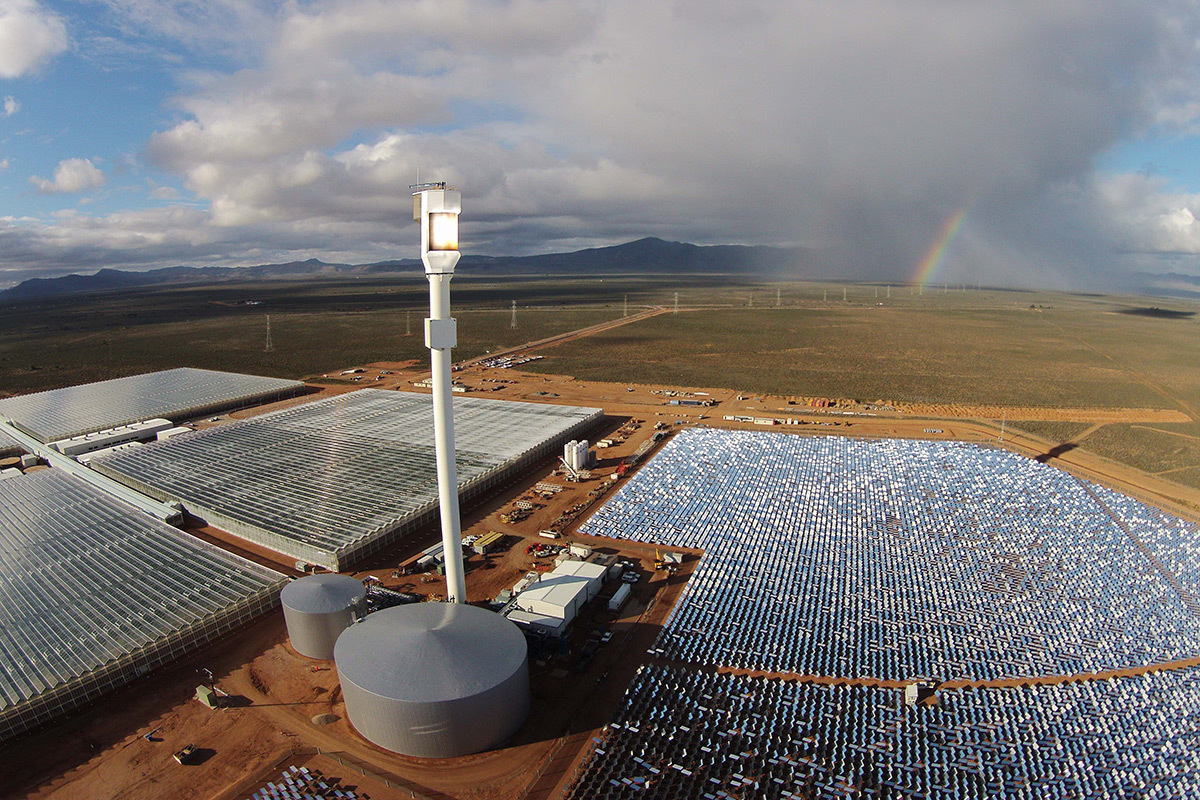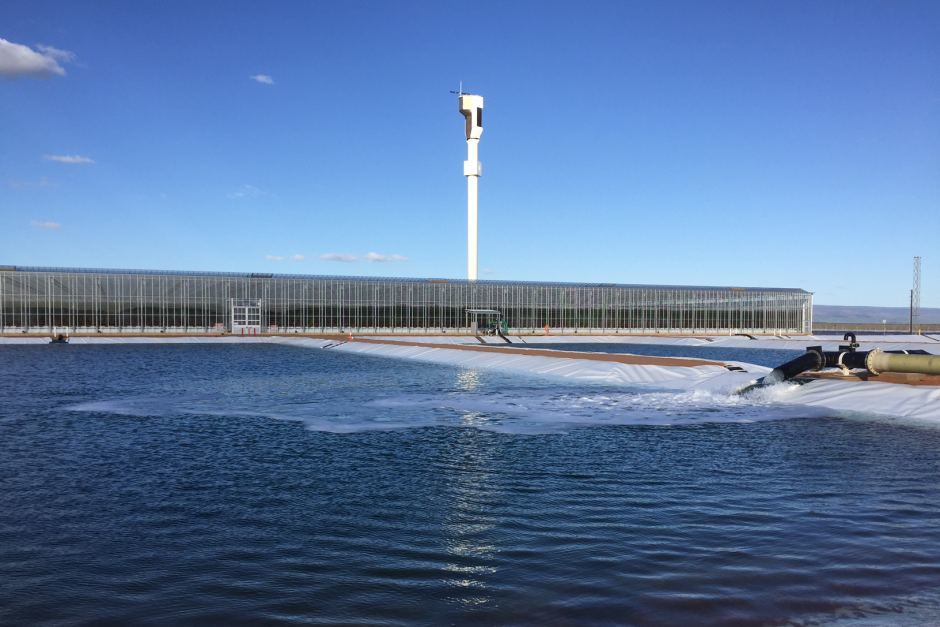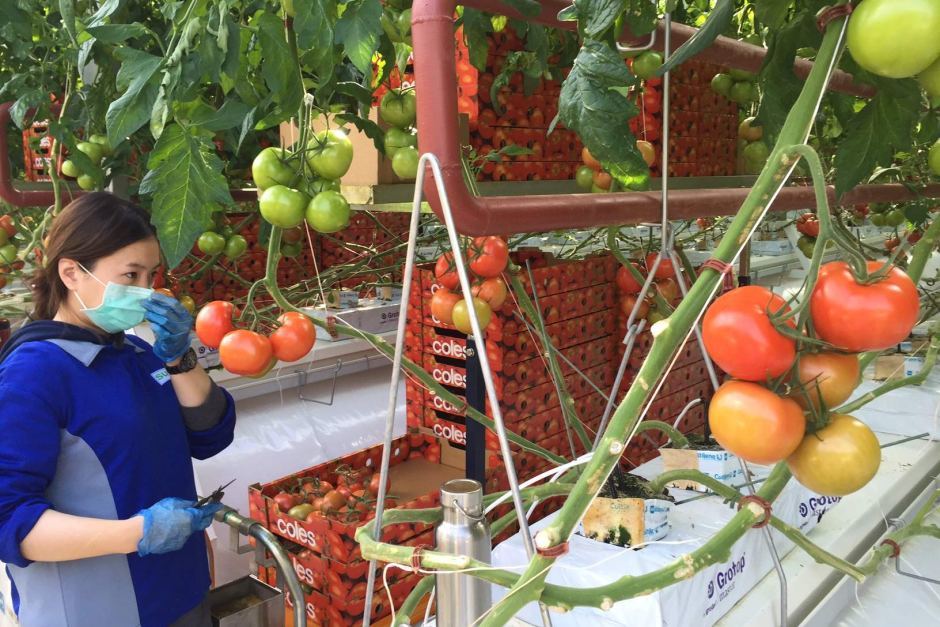The world's first hydroponic solar farm: sea water + sunlight = tomatoes

Greenhouses with tomatoes, mirrors and a solar hub at the Sundrop farm. Photo: Sundrop
What do you need for desert landscaping? How to collect a rich harvest in the dried soil, where almost nothing grows? Is farming possible if fresh water runs out, the soil is salted, and around - only the salty sea, as in the Crimea? It turns out that this is possible if you use intelligence and science.
Australian farm Sundrop is the first farm in the world that grows vegetables in the desert without using any fossil fuels. Only sunlight and sea water (and fertilizer).
A futuristic farm in South Australia produces 17,000 tons of tomatoes per year, which generates an income of about $ 16.9 million, considering the average cost of tomatoes on the Australian wholesale market is $ 994 per ton . Unlike conventional farms, neither underground water sources nor fossil fuels like gasoline are used here. Nothing. Even the local sandy soil is not used - the plants are placed in vessels, as in hydroponics. Along with water, necessary nutrients and fertilizers are supplied to the vessels.

From natural resources, only sunlight and sea water are taken. This model farm can be found widely in the future, writes the magazine New Scientist. Freshwater supplies on the Earth are gradually drying up, the population in Asia and Africa is growing rapidly, and the temperature on the Earth's surface is increasing due to the greenhouse effect. Thus, there are almost ideal conditions for a greenhouse farm.
Even pesticides are not needed here, because in the desert pests practically do not survive. And those who survive cannot penetrate an isolated greenhouse.
By 2050, due to population growth, people will need 50% more food than they do now. But all the agricultural land already occupied. So there are two options - either to increase the yield on existing areas, using more productive crops, or to develop new territories - the same deserts - while solving the problem of fresh water.
It turns out that the transition to innovative technologies in agriculture with the production of solar energy and the desalination of sea water is not only the most preferred option for the development of mankind. This is the only option. “Normal” agriculture no longer works, the time has come for major changes.
The design of the unique farm Sundrop has been developed and brought to mind by an international team of scientists for six years. The first experimental greenhouse was built in 2010. Four years later, began the construction of a full-scale structure with greenhouses on an area of 20 hectares. In the greenhouses planted 180,000 bushes of tomatoes. The official opening of the farm took place in 2016.

The centerpiece of the truss structure is the 127-meter tower of a solar concentrator, to which 23,000 mirrors reflecting the light reflect the rays of the earth. The hub provides steam, electricity and fresh water to the farm.
Water is pumped from Spencer Bay, which is part of the open Great Australian Bay, washing the south coast of Australia. Like the rest of the Indian Ocean, this bay contains salty seawater.
Thermal desalination of salt water (distillation) is carried out on the farm. The water is heated, and the steam is collected and condensed. The distillate is formed - it is absolutely pure fresh water. In the same way, water is desalinated on ships, for example. Nothing unusual.
On a good day, the solar power station generates 39 MW of electricity. This is sufficient for desalinating about a cistern of water. Distillation usually requires about 700 kcal per liter of water. But this is from the experience of ordinary distillers. We do not know the efficiency of the Sundrop power plant. Perhaps the engineers somehow improved the efficiency by playing around with osmotic pressure, for example.

A pond with sea water at the Sundrop farm.
To simplify the overall design, it was decided during preliminary tests to abandon direct water heating by sunlight. Now the plant generates electricity, and that is used for heating and distilling water in a separate container.
In any case, there is enough heat in the concentrator for desalination of the required volume of water and for obtaining the rest of the electricity needed by the farm.
The dry and hot climate of South Australia makes the land unsuitable for conventional agriculture. But using modern technologies and alternative energy, people can easily develop farms even in desert areas, where the climate is not much better than the Martian one.
The company Sundrop believes that the model of solar farms with concentrators can be applied in many warm countries where the soil is not very suitable for agriculture, but there are many sunny days a year. Now the company is opening another such farm in the Odemira region (Portugal), as well as in the state of Tennessee (USA). It is planned to open a second Australian farm. The construction of infrastructure for a solar farm of a similar scale cost $ 200 million. With an annual harvest of $ 16.9 million, the ROI reaches 8.45%. It turns out that, ideally, the farm should return the investment in about 12 years. Excellent result.
The management of Sundrop believes that this is a very profitable long-term investment, and governments can support private initiatives to create environmentally friendly farms, planting deserts, and desalinate seawater. For example, to exempt such enterprises from taxes. At least in the Crimea, such an initiative could save agriculture, which threatens to disappear due to lack of fresh water.

Tomatoes harvested at the Sundrop Farm are already on sale at Australian supermarkets.

Sundrop harvest packaging
